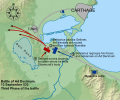Battle of Ad Decimum
| date | September 13, 533 |
|---|---|
| place | 10 miles south of Carthage |
| output | Decisive Byzantine victory |
| Parties to the conflict | |
|---|---|
| Commander | |
|
Gelimer |
|
| Troop strength | |
| approx. 17,000 | over 11,000 |
| losses | |
|
unknown |
unknown |
Iberian War
Dara - Satala - Callinicum
Vandal
War Ad Decimum - Tricamarum
Gothic War
1. Naples - 1. Rome - Verona - Faventia - Mucellium - 2. Naples - 2. Rome - 3. Rome - Sena Gallica - Busta Gallorum - Mons Lactarius - Casilinus
Moors wars
Mammes and Bourgaon - Babosis and Zerboule - Cillium - Marta - Fields of Cato
The battle of Ad Decimum on September 13, 533 between the army of the Vandals under their King Gelimer and that of the East Romans under the army master Belisarius signified with the Roman victory a decisive step towards the destruction of the Vandal Empire and the reintegration of North Africa into the Roman Empire .
The Latin name "ad Decimum" refers to the route marking, which generally indicates the distance of ten miles (at the tenth milestone) to the next significant or larger city, in this case to Carthage ten miles north .
initial situation
At this post, a Vandal army under the command of a brother Gelimer, Ammatas, with at least 11,000 men (this number may be clearly underestimated, since it presumably only includes the mounted elite troops , but not the infantry ), around the 17,000 Belisarius men to march on Carthage. Gelimer himself wanted to attack the Romans with his troops from behind. About 5,000 men of the best Vandal troops were not in the country at this time, but had been sent to Sardinia to suppress a rebellion there. This played into the hands of the imperial troops as well as the poor coordination of the Vandal armies.
The battle and its aftermath
procedure
The Eastern Roman historian Prokopios was an eyewitness to the battle he describes in the third book of his "War History": When the Romans approached, Gelimer sent 2,000 men under his nephew Gibamund to meet the opposing troops in the flank, but were wiped out . The troops at ad Decimum under Ammatas also acted unhappily, with Ammatas being killed. Gelimer's main force, on the other hand, was initially able to push back Belisarius's troops, and a victory seemed possible. When Gelimer learned of his brother's death, however, he evidently lost courage and failed to order one final decisive advance. This gave the oppressed Eastern Romans the opportunity to reorganize and counterattack, which they used consistently and drove the vandals to flight. The next day Belisarius entered Carthage, the capital of the Vandal Empire, victoriously. A few months later he defeated Gelimer a second time in the Battle of Tricamarum , which essentially ended the war. This unexpectedly great success, which had been achieved with very limited resources, probably only made Emperor Justinian I think of the possibility of regaining other former Western Roman areas (at least according to Mischa Meier ).
Evolution of the battle
Web links
- Texts by Prokop in Project Gutenberg (including vandal war, English)




